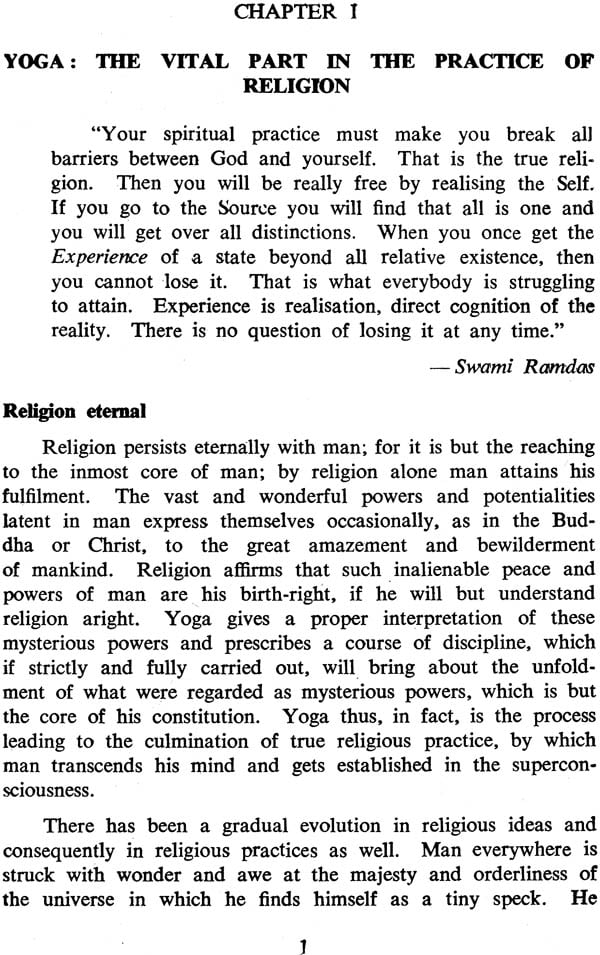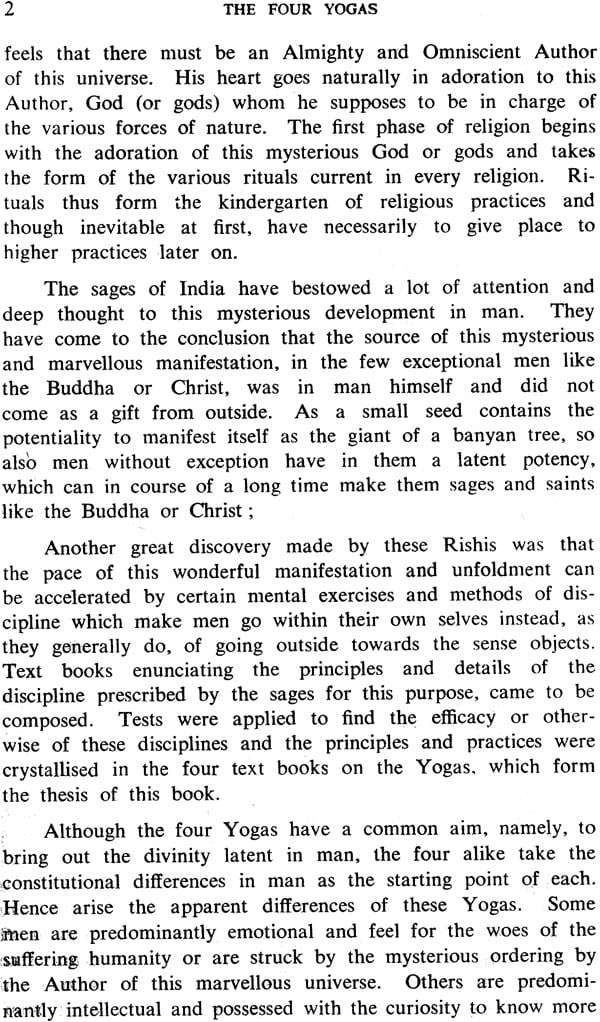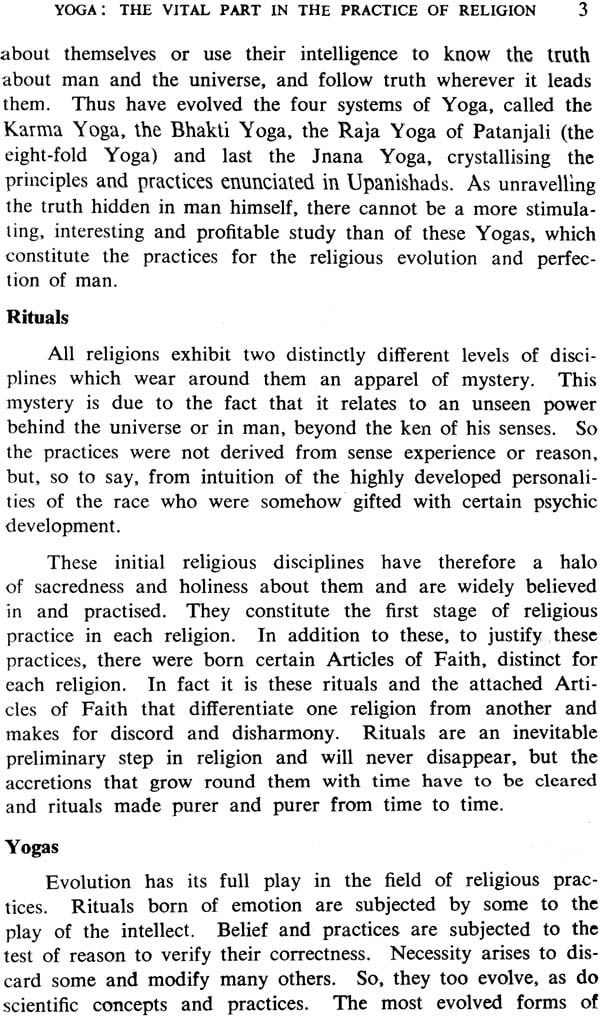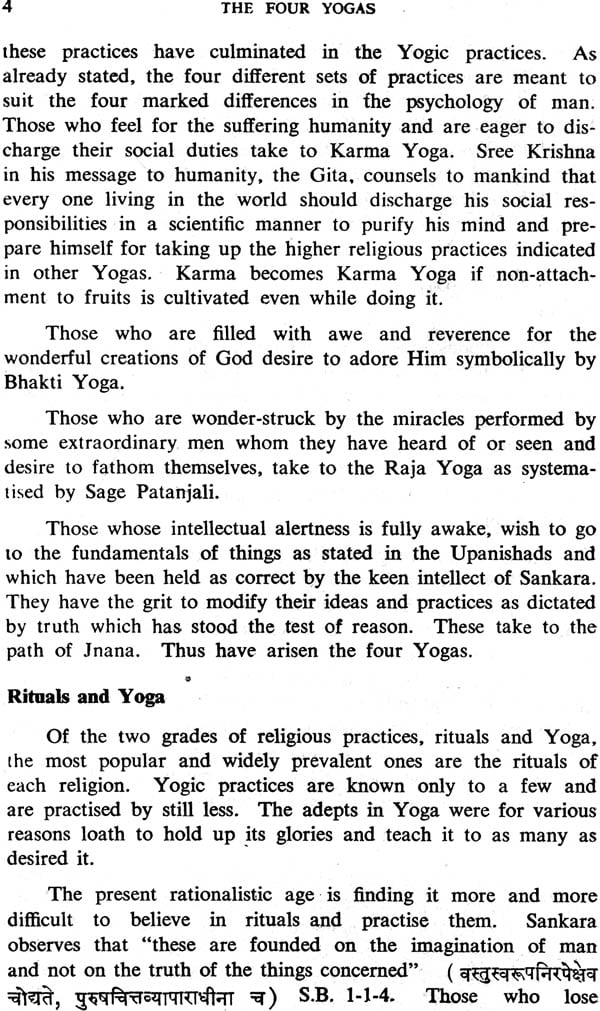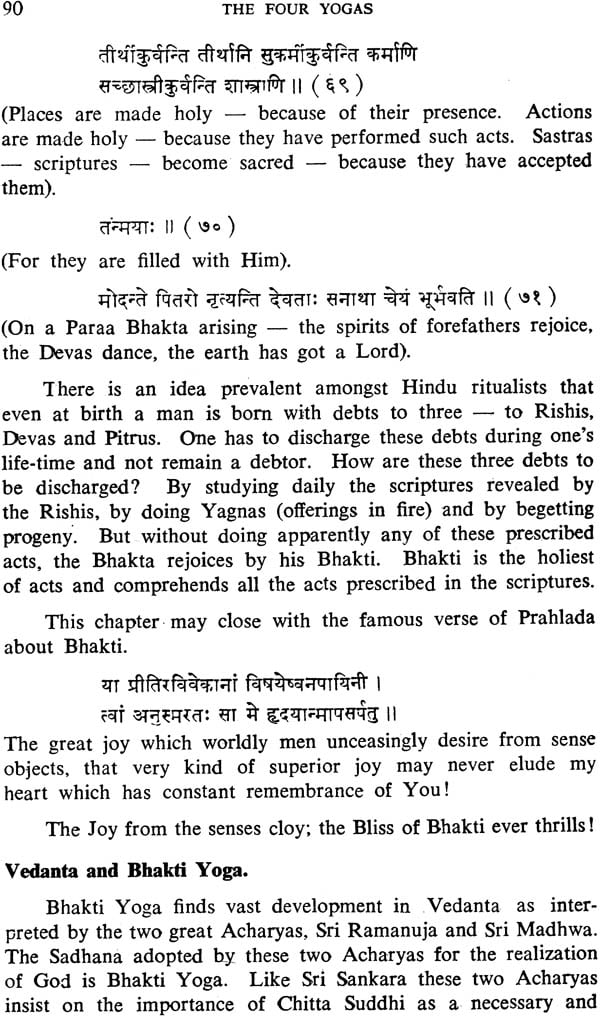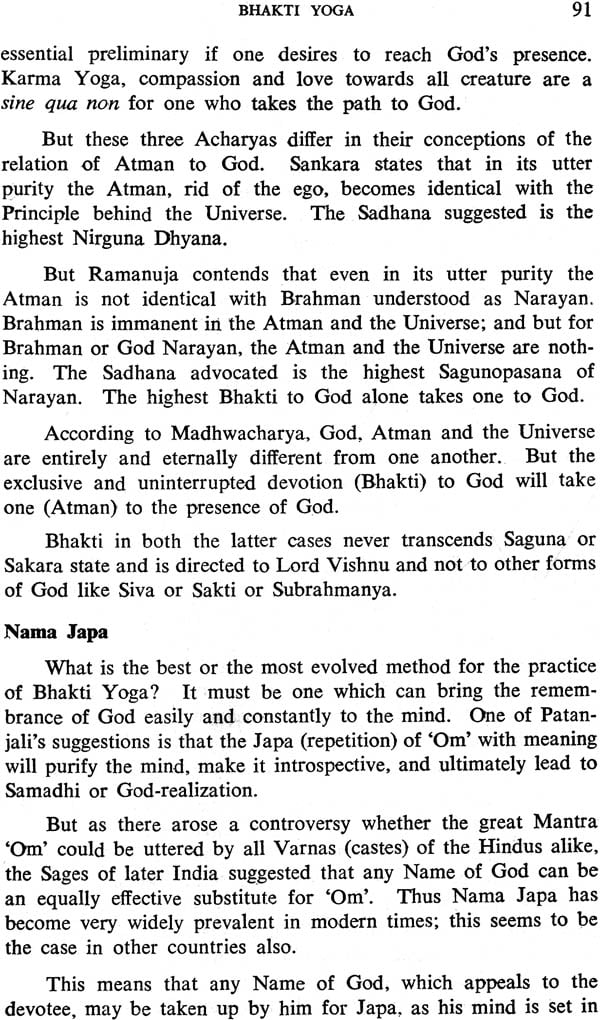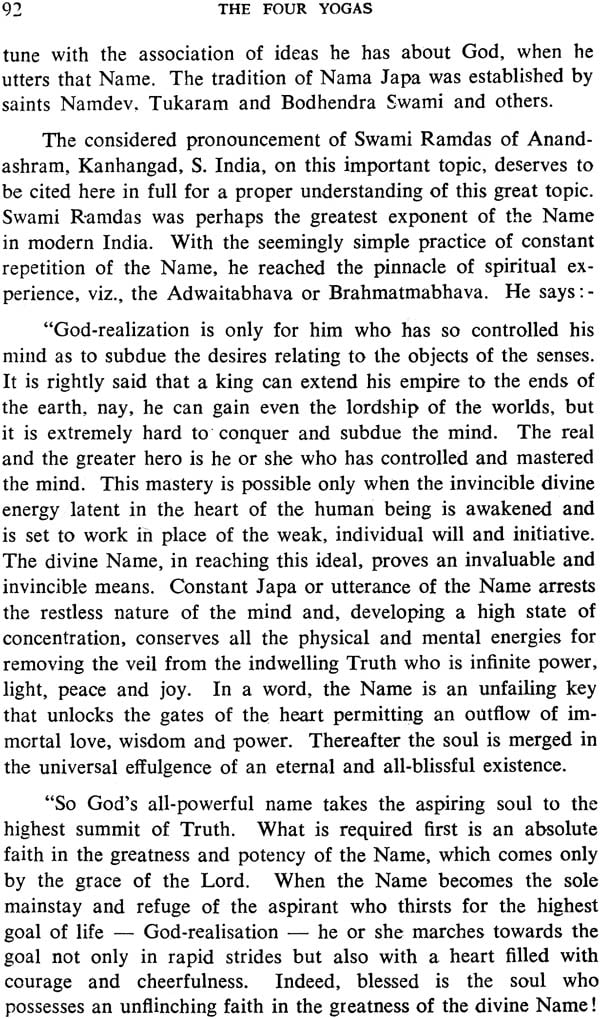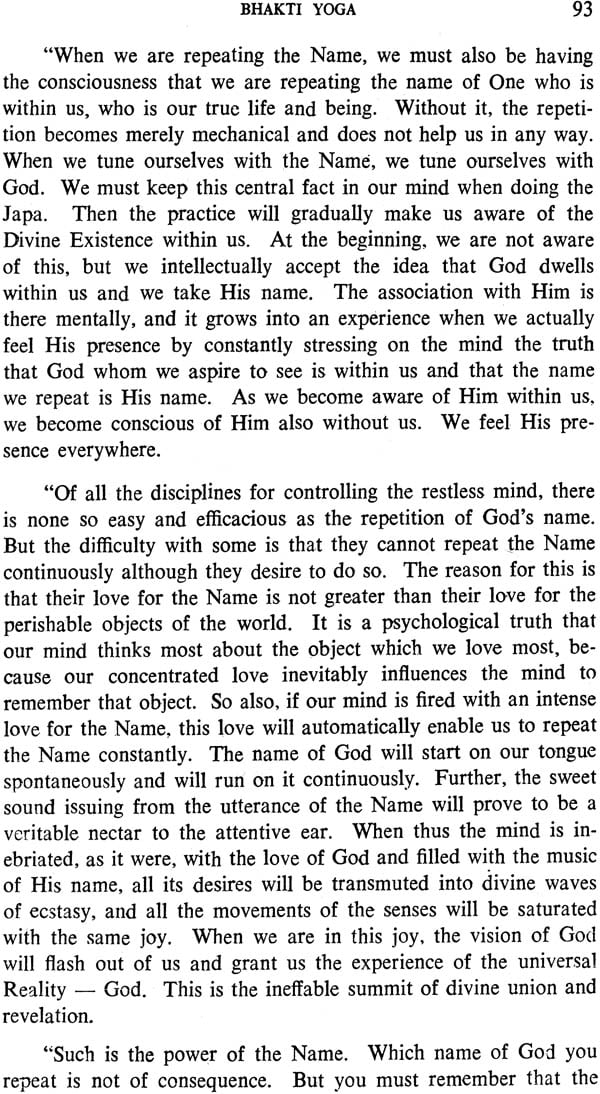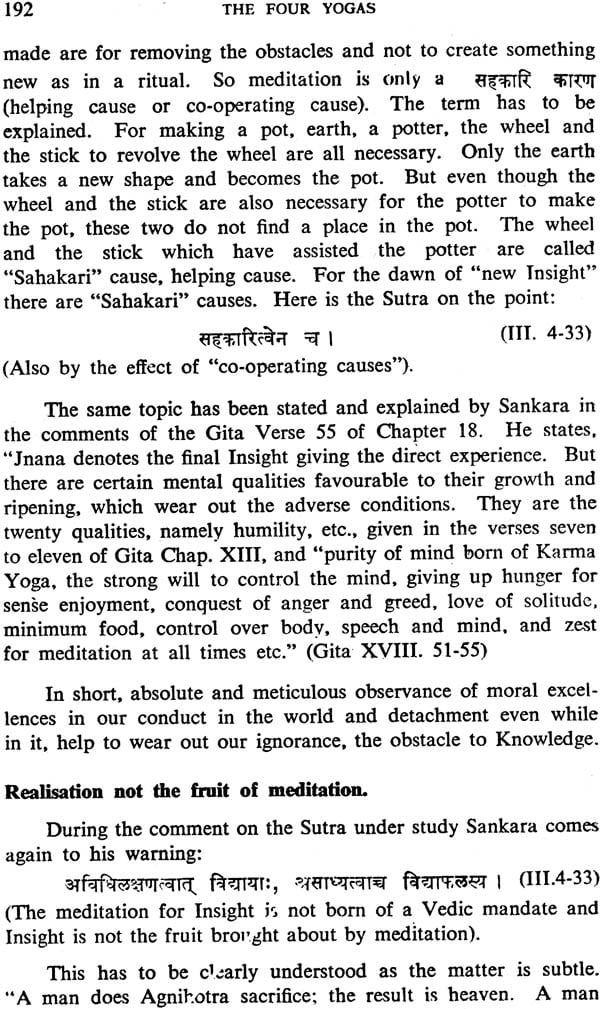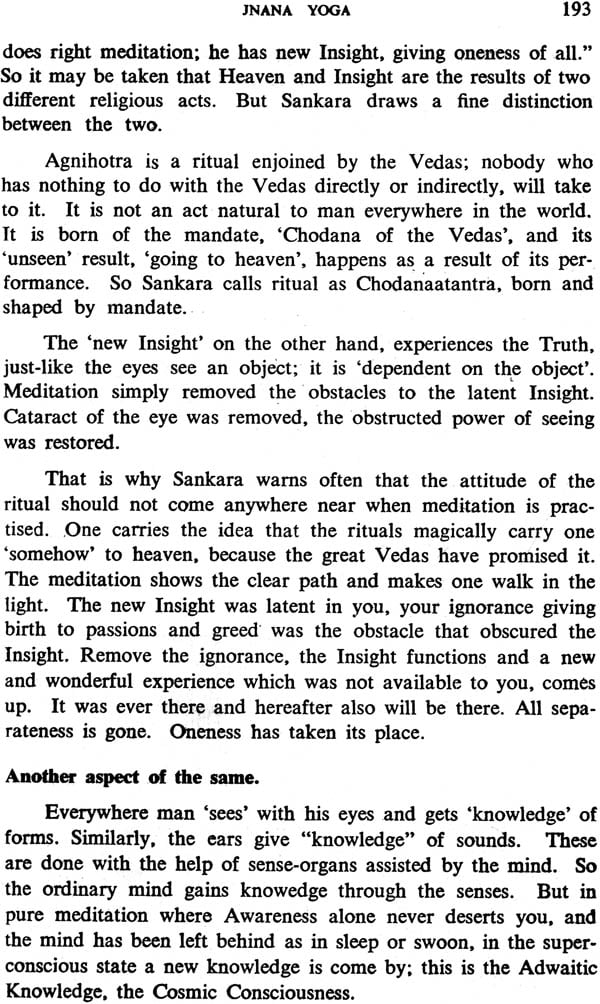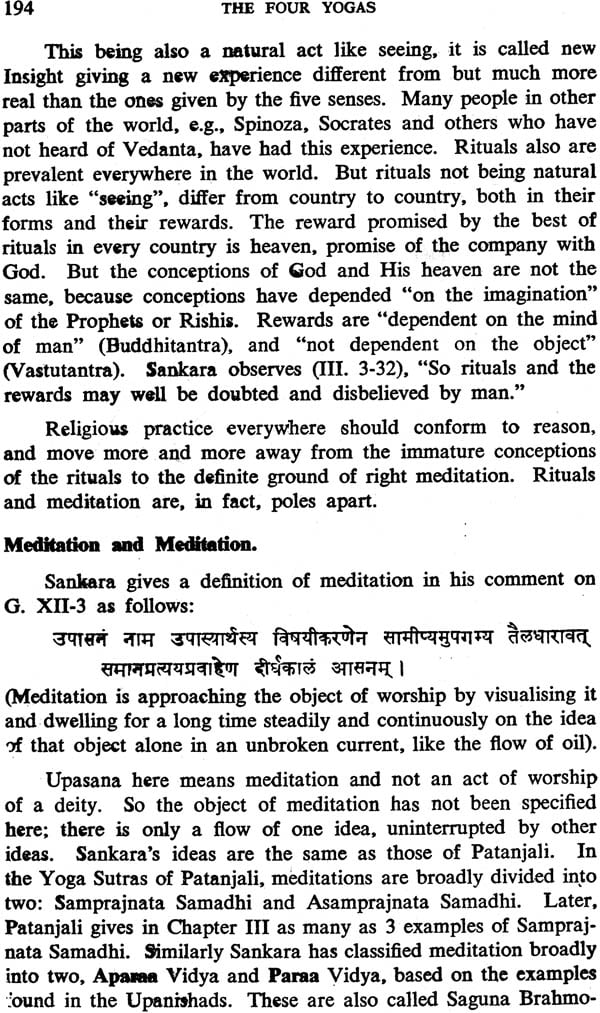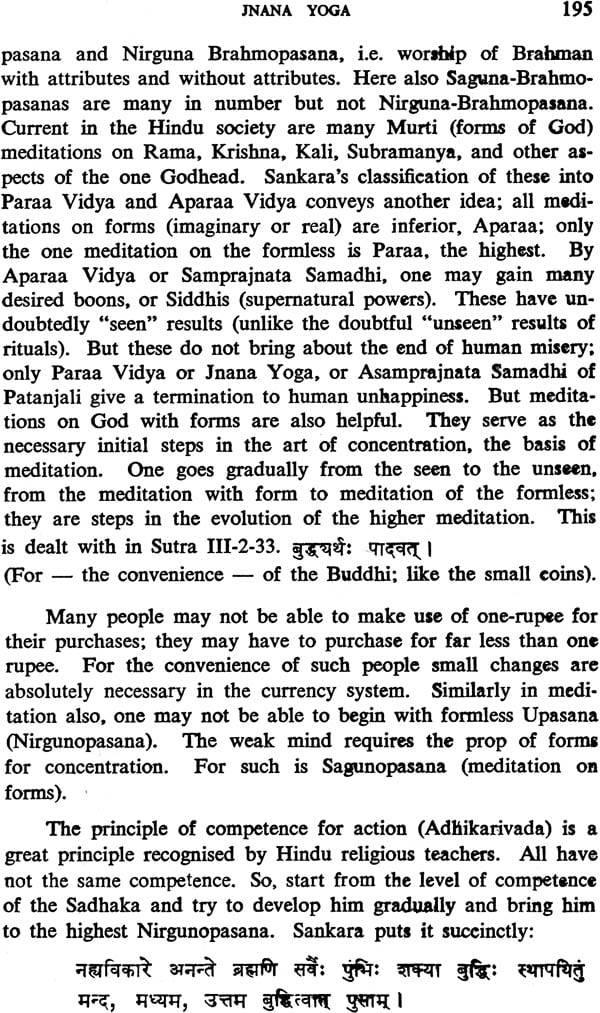
The Four Yogas Or The Four Paths To Spiritual Enlightenment (in the words of the ancient Rishis)
Book Specification
| Item Code: | IDE067 |
| Author: | Swami Atmananda |
| Publisher: | Bharatiya Vidya Bhavan |
| Language: | English |
| Edition: | 1991 |
| Pages: | 250 |
| Cover: | Paperback |
| Other Details | 8.7" X 5.7" |
| Weight | 310 gm |
Book Description
Science has been contributing to the material convenience and comfort of man, so steadily and in such progressive measure that we now live in a condition of physical ease incomparable beyond that in which our forefathers did at the turn of the century. Yet this has not increased our genera happiness or brought us the inward joy of living. Indeed the failure of Science in the procurement of genuine joy has been as ignominious as its success in the creation of artificial comfort has been wonderful.
Nor is this a matter of surprise. Peace, which is the basis of all real joy, can never be the fruit of the labours of Science. For Science works and can work only with the things of passing existence, the destructible materials of the physical plane; Peace and Joy are the permanent values of the Essence of Living-the Spirit.
The understanding of the Spirit-Spirituality-alone can confer permanent Peace on man and make him fit for real Joy. The Spirit, which is but the universal aspect of God, is the Goal of the seeker everywhere. The different religions of the world differ not in this Goal but in the ways which they open to mankind to reach it.
Hinduism is nothing if not catholic. Its catholicity discovered, earlier than all other religious systems, the differences in the mental make-up of man. And, in its understanding sympathy, Hinduism found and prescribed for the benefit of mankind in all grades and planes of intellect and mind different paths in Spirituality.
These different paths are different only in their courses. Both at the starting point and at the destination they join the same points. Here is the individual soul-the pilgrim-, and there is the Universal Soul-the Spirit, God, or whatever we choose to call it. Even the differences in the paths are felt only while one traverses them, and produce different passing results in the duration of travel, but the moment one 'arrives' the awareness of the paths and their qualities disappears entirely. Oneness results.
Karma, Bhakti, Raja and Jnana Yogas are the four paths dealt with in this book. Sri Krishna, Narada, Patanjali and Vyasa formulated and expounded these Yogas. The author, with his knife-edge intellect, has cut off the intricacies of these principal Yogas and presented them to the reader in their essential and fundamental quality as clear paths each one of which he can tread with the complete confidence that, by following it with unfaltering faith, he will 'arrive'.
Swami Atmanands (S. Neelakanta Iyer) was born in 1889 in Chittur, Palghat District, Kerala. As a B.A.L.T. he was in private educational service till1930 when he joined the Salt Satyagraha as one of the leaders of that movement in Kerala. He was the General Captain of the Salt Satyagraha volunteers at Payyanur.
He came into close contact with Gandhiji at Madras in 1916. He was an active worker in the Congress since 1919. He was at the Vaikom Satyagraha camp as Gandhiji's personal attendant, which duty he did every time Gandhiji visited Kerala. In 1929 he acted as the local secretary of Pandit Malaviyajji when he toured Kerala. He was the first secretary of the Harijan Sevak Sangh, Cochin-Travancore area, from 1932 to 1934. Form August 1934 to May 1937 he was an honorary worker in the Madras Ramakrishna Mutt, working in the Student's Home, Mylapore, Madras.
He was one of the organizers of the Cochin State Praja Mandal in 1940 and continued as its President, except for a short break, till 1950. In 1943 as the President of the Praja Mandal he attended the memorable "Quit India" Bombay A.I.C.C. session and on return was arrested and jailed at Trichur. It was while in jail that he arranged the teachings of Sankara. A devotee of Swami Ramdas since 1939 he took Sanyas from him in 1950. He was the Acharya of the Veda Sastra Pathasala, Chittur, from 1950 to 1963. He was also a member of the Jnana Ashram, Parlikad, Kerala, and the Working President, Bharat Sadhu Samaj, Kerala Branch.
A new call is being heard that Science and Spirituality should rule the world; Science alone is not adequate. The innumerable inventions of Science and Technology may add to the passing comforts and conveniences of man, but Spirituality alone can assign values and confer on man permanent peace and joy.
The nature of Science is well comprehended by man but not so well the characteristics of Spirituality. The purpose of this book is to bring-out the essential ideas centering round the word Spirituality.
The modern tendency in the West is to make a sharp distinction between Religion and Spirituality. Religion was a word which had a wide enough connotation and, then, it included elements of Spirituality within its sweep. But, as it came to be recognised, that there has been evolution in religious ideas also the use of the word ‘Religion’ is now being restricted to certain of its earlier aspects and the word ‘Spirituality’ is used to denote the more evolved aspects.
Religious Rites or Rituals of various sorts exist in every religion; be it Hinduism, or Christianity, or others. Rituals arc the first manifestations in man’s attempt to propitiate the mysterious force, which man intuitively felt as guiding his destiny. This mysterious and mighty Being was called God. Symbolic Rites came into being to obtain from God various favours which were beyond man’s power to acquire. This is a feature which is invariably found in every Religion in the world; only these Rites, which were symbolic, differed with each Religion. The Philosophy of Religion steadily grew up, explaining the relation of man to God. The present tendency is to restrict the use of the word ‘Religion’ to its earlier phase.
The history of Vedic Religion in India shows the same phenomena. At first the word ‘Vedas’ comprehended the three distinct portions of the Vedas, viz., Samhitas (collection of Hymns in praise of the it the-if Brahmanas (the portions prescribing and delineating Rituals). and the Upanishads (the philosophical portions).
The Upanishads deal with the Spirit, the indweller in man; not with God nor with Rituals to propitiate Him. So, one great ancient investigator, about the significance of the Vedas did not End the necessity to include the Upanishads within the scope of his work. The Upanishads then came to be called ‘Vedanta’ (the concluding portions of the Vedas) in contrast with the rest of the Vedas known as ‘Vedas’. Similarly the word ‘Religion’ has shrunk in the extent of its meaning and the word ‘Spirituality’ has come to signify the more evolved part of Religion. The Vedanta is called Adhyatma Vidya, the Science regarding the Atman or the Spirit of man, as also the method of meditation useful for purifying the mind and realizing the Atman. Now, among the Hindus, a Vedantin (one who takes to Vedanta. giving up the Rituals) has come to be recognised as a man of far higher religious evolution than a Karmi (one who still sticks to Rituals).
So the rise of the word ‘Spirituality’ denotes that religious men of all communities in general want to forge ahead in the current religious evolution. It calls the attention of humanity to the fact that it is time they seek to realize the One Spirit dwelling within all of them, rather than to continue blindly the performance of Rituals in order to propitiate God and receive gifts from Him. Every votary of Spirituality will welcome this higher outlook.
This book, The Four Yogas, is essentially meant to place before the world the glorious attempts made by Sri Krishna and the three Indian Rishis Narada, Patanjali and Vyasa — as also by their eminent commentator, Sri Sankara, to enunciate and elucidate the most advanced religious principles and practices conducive to the fostering of Spirituality in India. It is in the hope that their teachings may be useful to the world at this moment, that this book is being presented.
Rituals, though a necessary and inevitable preliminary step for the votaries of every Religion like the mother’s milk for the baby —— have to be outgrown. The Sadhakas should steadily advance in Spirituality and take to meditation and contemplation — the most evolved forms of religious discipline. The world has first to recognise this fact before the people take to it in larger numbers.
But in between the two poles of Religion, lies Ethics. sense-control and mind-control. A practice of these, with the right attitude of detachment, forms the essential foundation for the magnificent superstructure of Spirituality. Ethics and control of the mind are essential not only for Spirituality but also for welfare and peace in this warring world. Discords, both economic and social. can end only if the importance of Ethics is recognised and practised by the people.
The religious heads of every religion will do well to educate and advise their followers to give more importance to the practice of Ethics in their lives. The whole world agrees on this point, only it is not given the needed attention. The Pontifices of all Religions can build a World Union of Religions on Ethics. On this common basis of Ethics a common superstructure of Spirituality will come naturally.
This book will have served its purpose if it paves the way for a greater recognition of Ethics and Spirituality. The methods for the cultivation of Spirituality, as advocated by the Sages of India, form the theme of this book.
The Sanskrit passages quoted in the book give, so to say, the cream of spiritual science and practice. They are recommended for daily Parayana (the reverential reading of portions of Scriptures). They will serve to keep in memory the principles and, what is more, give the devoted reader the needed correctives in his spiritual practice.
| Chap. I : | YOGA: The Vital Part in The Practice of Religion | |
| Religion eternal | 1 | |
| Rituals | 3 | |
| Yogas | 3 | |
| Rituals and Yoga | 4 | |
| Yoga poles apart from Rituals | 8 | |
| The Practice of Yoga | 9 | |
| The Common Ground of Religions and Yogas | 11 | |
| The Texts
| 12 | |
| Chap. II : | RITUALS - An Assessment | |
| Origin | 15 | |
| The Sharp Division between Karma and Jnana | 16 | |
| The Result of Rituals | 18 | |
| Results Change with Mental Attitude | 19 | |
| History of Rituals in India | 20 | |
| The Pinnacle of Ritualism | 21 | |
| The Grotesque Claims of Mimamsa | 21 | |
| Sankara's Fundamental Propositions | 22 | |
| The Greatest Argument | 23 | |
| Sankara's Purpose | 23 | |
| Any Other Purpose for Ritual | 24 | |
| Rituals Change Form | 25 | |
| Sankara and Mandana Misra | 26 | |
| Conclusion
| 30 | |
| Chap. III : | KARMA YOGA | |
| Genesis of Karma Yoga | 32 | |
| Theory of Karma | 33 | |
| The Vicious Circle | 34 | |
| Another Dilemma | 35 | |
| Rationale of Karma Yoga | 37 | |
| Humanitarianism and Karma Yoga | 41 | |
| Humanitarian work not the only field | 44 | |
| Ritual and Karma Yoga | 45 | |
| Is Karma Yoga an independent one? | 45 | |
| Karma Yoga only an indispensable first step | 46 | |
| Karma Yoga, the lower rung to other Yogas | 50 | |
| Karma to evolve into Karma Yoga | 51 | |
| Some misconceptions | 55 | |
| Renunciation of Action | 57 | |
| The Sanyasin and the World | 58 | |
| Gita Verses on Karma Yoga | 58 | |
| The Correct Light on Karma | 63 | |
| Spiritual Evolution versus Material Evolution
| 63 | |
| Chap. IV : | BHAKTI YOGA | |
| Introduction | 66 | |
| Bhakti in Religious Literatuer | 68 | |
| Gita on Bhakti | 70 | |
| Vedic Rituals versus Bhakti | 72 | |
| Paraa Bhakti of the Gita | 74 | |
| Naarada's Bhakti Sutras | 75 | |
| Introduction | 75 | |
| The Attributes of Paraa Bhakti | 77 | |
| A caution regarding Paraa Bhakti | 80 | |
| Superiority of Bhakti Yoga | 82 | |
| Gauni Bhakti or Preliminary Bhakti | 84 | |
| Earlier Disciplines - negative and positive | 86 | |
| Disciplines for Paraa Bhakti | 87 | |
| Snares on the path | 88 | |
| Beneficial to the world also | 89 | |
| Vedanta and Bhakti Yoga | 90 | |
| Nama Japa
| 91 | |
| Chap. V : | THE PSYCHOLOGY OF YOGA | |
| The Principle of Evolution | 95 | |
| Creation or Evolution? | 96 | |
| Evolution in India and the West | 96 | |
| Principle of Evolution | 97 | |
| The Great Discoveries of Kapila | 98 | |
| The Gunas of the Mind | 99 | |
| Yogic Psychology | 100 | |
| Purusha | 102 | |
| Atman | 102 | |
| Ahamkara | 102 | |
| Maya | 102 | |
| Why is Maya incomprehensible? | 103 | |
| Aim of Yoga | 103 | |
| The Going in Yoga | 104 | |
| Evolution in Universe | 104 | |
| The Tanmatras | 105 | |
| Purusha or Atman or Seer
| 106 | |
| Chap. VI : | RAJA YOGA OF PATANJALI OR THE SCIENCE OF YOGA | |
| General Observations | 109 | |
| The Human Problem and its Solution | 110 | |
| Some Important Definitions of Terms | 112 | |
| Chitta | 112 | |
| Vritties | 112 | |
| Restraint | 113 | |
| Concentration | 113 | |
| Samadhi | 113 | |
| Definition of God | 114 | |
| Drashta, (the Seer) and Drishya (the seen) | 115 | |
| Evolution and not Creation | 118 | |
| False Identification or Avidya | 120 | |
| Maya and the means of dispelling it | 122 | |
| Samskaras (impressions) and their conquest | 124 | |
| About Prarabdha | 124 | |
| Now about Aagami and Sanchita: | 125 | |
| Prati-Prasava (reverse of birth) | 125 | |
| Prati-Prasava and Operation | 126 | |
| General aids to Yoga | 127 | |
| Specific aids to Yoga | 128 | |
| The Specific Aids to Yoga - Its Eight Limbs dealt with one by one | 129 | |
| Ethical Excellence Essential | 130 | |
| And Not Rituals | 130 | |
| Yama and Niyama | 132 | |
| Definition of Yama | 132 | |
| The Effect of Ethical Excellence | 133 | |
| Posture - Bodily aids | 134 | |
| Pranayama | 135 | |
| Pratyahara | 136 | |
| Caution | 136 | |
| The Heart of Yogic Practice | 136 | |
| Freedom is beyond even Dharma | 138 | |
| Samadhi with Seed and Siddhis | 138 | |
| Siddhis - Their Nature | 139 | |
| Other Aspects about Samadhi | 140 | |
| Varieties of Samadhis | 141 | |
| (a) Savitarka | 141 | |
| (b) Nirvitarka | 141 | |
| (c) Savichara and (d) Nirvichara | 142 | |
| (e)Sananda and (f) Asmita | 142 | |
| Samprajnata Samadhi | 143 | |
| Asamprajnata Samadhi | 143 | |
| Other Methods to Samadhi | 144 | |
| The Doctrine of Karma and Rebirth | 145 | |
| Causes of misery and rebirth | 145 | |
| The function of God | 147 | |
| Karma and Progress | 147 | |
| Kaivalya | 148 | |
| Kaivalya from Other Viewpoints | 151 | |
| Vedanta Improves on Yoga | 152 | |
| Sarvatmabhava (becoming one with all) | 153 | |
| The Basis of Ethics | 153 | |
| The Gita on Yoga
| 154 | |
| Chap. VII : | JNANA YOGA | |
| The Basis of Jnana Yoga | 159 | |
| Relation of Vedanta to other Schools | 160 | |
| The Preliminary Steps | 161 | |
| The Object of Meditation here | 162 | |
| Atman does Exist | 162 | |
| Upanishadic Statement on Atman | 164 | |
| Transcending the Sense - Its double aspects | 166 | |
| Jnana Yoga | 167 | |
| Rituals inadequate | 169 | |
| Ethics Essential | 170 | |
| Rishis are not destructive but constructive | 170 | |
| Reason will help to take to Ethics | 170 | |
| Viveka and Vairagya | 170 | |
| Desire for Freedom | 171 | |
| Karma Yoga in Daily Life | 172 | |
| Interpretation supported by Sutras | 172 | |
| Difference between Karma and Jnana | 176 | |
| The New Insight | 178 | |
| Two Kinds of Meditation | 182 | |
| Fruit of Knowledge here and now | 184 | |
| Jnana Sadhana - How Long? | 185 | |
| Important caution in meditation | 186 | |
| Contrast in the Attitude of the Mind in Karma and Jnana | 187 | |
| Other Aids | 188 | |
| Fulfilment and its Nature | 189 | |
| When does the Insight Dawn? | 191 | |
| The Co-operation Causes | 191 | |
| Realisation not the fruit of meditation | 192 | |
| Another aspect of the same | 193 | |
| Meditation and Meditation | 194 | |
| Pratika Upasana | 196 | |
| Jnana Yoga and Patanjali Yoga | 197 | |
| The Superiority of Jnana as seen from result | 198 | |
| The World no Illusion | 199 | |
| Man's Bondage too real before Freedom | 202 | |
| The Gita and Jnana Yoga
| 202 | |
| Chap. VIII : | THE COMMON FEATURES OF YOGAS | |
| The Essentials of the Yogas | 204 | |
| The Basis of Yoga | 204 | |
| The Evolution in the Idea of God | 205 | |
| Evolution of Sadhana also | 206 | |
| Charity and Ethics | 206 | |
| The Super conscious Experience or Yoga | 207 | |
| The Three Steps | 207 | |
| Science and Spirituality | 209 | |
| Why the Different Yogas? | 210 | |
| The New Insight of Experience | 211 | |
| The Great Mystery or Maya | 211 | |
| Taboos to be observed | 213 | |
| Rituals - The weak and ineffective Means | 214 | |
| Yatna (effort) is necessary, though not Karma (Rituals) | 216 | |
| Ethics: The First Positive Step in Spirituality | 217 | |
| Karma Yoga | 218 | |
| Meditation: the Final and The Most Important Step
| 219 | |
| Appendix I : | SHAD DARSANAS (SIX SYSTEMS OF PHILOSOPHY) | |
| A Brief Summary | 224 | |
| The Form of the Darsanas | 227 | |
| Subject Matter of the Darsanas | 227 | |
| Vedas | 228 | |
| God | 228 | |
| Atman and Mind | 228 | |
| Universe | 229 | |
| Pramanas - Sources of Knowledge | 229 | |
| Moksha | 229 | |
| A Summary
| 230 | |
| Appendix II : | KUNDALINI YOGA BY SWAMI RAMDAS | 231 |
| Note
| 233 | |
| Appendix III : | SAMADHIS | 233 |
| Samprajnata Samadhi - A Sabeeja Samadhi | 233 | |
| Asamprajnata Samadhi - The Nirbeeja Samadhi | 234 | |
| Bhava Samadhi | 234 | |
| Savikalpa Samadhi | 235 | |
| Nirvikalpa Samadhi | 235 | |
| Sahaja Samadhi | 235 |
